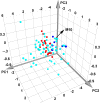Systems pharmacology reveals the unique mechanism features of Shenzhu Capsule for treatment of ulcerative colitis in comparison with synthetic drugs
- PMID: 30385774
- PMCID: PMC6212405
- DOI: 10.1038/s41598-018-34509-1
Systems pharmacology reveals the unique mechanism features of Shenzhu Capsule for treatment of ulcerative colitis in comparison with synthetic drugs
Abstract
In clinic, both synthetic drugs and Shenzhu Capsule (SZC), one kind of traditional Chinese medicines (TCMs), are used to treat ulcerative colitis (UC). In our study, a systems pharmacology approach was employed to elucidate the chemical and mechanism differences between SZC and synthetic drugs in treating UC. First, the compound databases were constructed for SZC and synthetic drugs. Then, the targets of SZC were predicted with on-line tools and validated using molecular docking method. Finally, chemical space, targets, and pathways of SZC and synthetic drugs were compared. Results showed that atractylenolide I, atractylone, kaempferol, etc., were bioactive compounds of SZC. Comparison of SZC and synthetic drugs showed that (1) in chemical space, the area of SZC encompasses the area of synthetic drugs; (2) SZC can act on more targets and pathways than synthetic drugs; (3) SZC can not only regulate immune and inflammatory reactions but also act on ulcerative colitis complications (bloody diarrhea) and prevent UC to develop into colorectal cancer whereas synthetic drugs mainly regulate immune and inflammatory reactions. Our study could help us to understand the compound and mechanism differences between TCM and synthetic drugs.
Conflict of interest statement
The authors declare no competing interests.
Figures







Similar articles
-
Comparison of the molecular mechanisms of Fuzi Lizhong Pill and Huangqin decoction in the treatment of the cold and heat syndromes of ulcerative colitis based on network pharmacology.Comput Biol Med. 2023 Jun;159:106870. doi: 10.1016/j.compbiomed.2023.106870. Epub 2023 Apr 5. Comput Biol Med. 2023. PMID: 37084637
-
Network Pharmacology Prediction and Molecular Docking-Based Strategy to Discover the Potential Pharmacological Mechanism of Huai Hua San Against Ulcerative Colitis.Drug Des Devel Ther. 2021 Jul 28;15:3255-3276. doi: 10.2147/DDDT.S319786. eCollection 2021. Drug Des Devel Ther. 2021. PMID: 34349502 Free PMC article.
-
Investigation of the Active Ingredients and Mechanism of Hudi Enteric-Coated Capsules in DSS-Induced Ulcerative Colitis Mice Based on Network Pharmacology and Experimental Verification.Drug Des Devel Ther. 2021 Oct 8;15:4259-4273. doi: 10.2147/DDDT.S326029. eCollection 2021. Drug Des Devel Ther. 2021. PMID: 34675488 Free PMC article.
-
Progress in active compounds effective on ulcerative colitis from Chinese medicines.Chin J Nat Med. 2019 Feb;17(2):81-102. doi: 10.1016/S1875-5364(19)30012-3. Chin J Nat Med. 2019. PMID: 30797423 Review.
-
Chinese Medicine in the Treatment of Ulcerative Colitis: The Mechanisms of Signaling Pathway Regulations.Am J Chin Med. 2022;50(7):1781-1798. doi: 10.1142/S0192415X22500756. Epub 2022 Aug 11. Am J Chin Med. 2022. PMID: 35950375 Review.
Cited by
-
Decoding the Mechanism of Huanglian Jiedu Decoction in Treating Pneumonia Based on Network Pharmacology and Molecular Docking.Front Cell Dev Biol. 2021 Feb 18;9:638366. doi: 10.3389/fcell.2021.638366. eCollection 2021. Front Cell Dev Biol. 2021. PMID: 33681222 Free PMC article.
-
Network Pharmacology with Metabolomics Study to Reveal the Mechanisms of Bushen Huoxue Formula in Intervertebral Disc Degeneration Treatment.Drug Des Devel Ther. 2024 Feb 21;18:493-512. doi: 10.2147/DDDT.S451197. eCollection 2024. Drug Des Devel Ther. 2024. PMID: 38405577 Free PMC article.
-
Niloticin binds to MD-2 to promote anti-inflammatory pathway activation in macrophage cells.Int J Immunopathol Pharmacol. 2022 Jan-Dec;36:3946320221133017. doi: 10.1177/03946320221133017. Int J Immunopathol Pharmacol. 2022. PMID: 36314579 Free PMC article.
-
In silico investigation of Panax ginseng lead compounds against COVID-19 associated platelet activation and thromboembolism.J Ginseng Res. 2023 Mar;47(2):283-290. doi: 10.1016/j.jgr.2022.09.001. Epub 2022 Sep 17. J Ginseng Res. 2023. PMID: 36160270 Free PMC article.
-
Mechanisms of Gynostemma pentaphyllum against non-alcoholic fibre liver disease based on network pharmacology and molecular docking.J Cell Mol Med. 2022 Jul;26(13):3760-3771. doi: 10.1111/jcmm.17410. Epub 2022 Jun 3. J Cell Mol Med. 2022. PMID: 35665440 Free PMC article.
References
Publication types
MeSH terms
Substances
LinkOut - more resources
Full Text Sources
Medical

